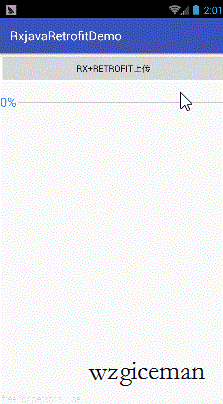背景
在实际运用中上传是一个必不可少的功能,所以我们在封装二的基础上加入上传的功能,同时需要附带上传进度!
效果

实现
1.定义service接口
注意:Multipart是指定大文件上传过程中的标示,一般上传图片的过程中我们需要附带信息,所以我们需要用到@part指定传递的数值,MultipartBody.Part是指定传递的文件;
@Multipart
@POST("AppYuFaKu/uploadHeadImg")
Observable<BaseResultEntity<UploadResulte>> uploadImage(@Part("uid") RequestBody uid, @Part("auth_key") RequestBody auth_key, @Part MultipartBody.Part file);
2.加入进度条
retrofit是基于okhttp的处理,所以我们可以自定义RequestBody,复写writeTo(BufferedSink sink)方法,得到传递的进度数据
public class ProgressRequestBody extends RequestBody {
private final RequestBody requestBody;
private final UploadProgressListener progressListener;
private BufferedSink bufferedSink;
public ProgressRequestBody(RequestBody requestBody, UploadProgressListener progressListener) {
this.requestBody = requestBody;
this.progressListener = progressListener;
}
/**
* 重写调用实际的响应体的contentType
* @return MediaType
*/
@Override
public MediaType contentType() {
return requestBody.contentType();
}
/**
* 重写调用实际的响应体的contentLength
* @return contentLength
* @throws IOException 异常
*/
@Override
public long contentLength() throws IOException {
return requestBody.contentLength();
}
/**
* 重写进行写入
* @param sink BufferedSink
* @throws IOException 异常
*/
@Override
public void writeTo(BufferedSink sink) throws IOException {
if (null == bufferedSink) {
bufferedSink = Okio.buffer(sink(sink));
}
requestBody.writeTo(bufferedSink);
bufferedSink.flush();
}
/**
* 写入,回调进度接口
* @param sink Sink
* @return Sink
*/
private Sink sink(Sink sink) {
return new ForwardingSink(sink) {
long writtenBytesCount = 0L;
long totalBytesCount = 0L;
@Override
public void write(Buffer source, long byteCount) throws IOException {
super.write(source, byteCount);
writtenBytesCount += byteCount;
if (totalBytesCount == 0) {
totalBytesCount = contentLength();
}
Observable.just(writtenBytesCount).observeOn(AndroidSchedulers.mainThread()).subscribe(new Action1<Long>() {
@Override
public void call(Long aLong) {
progressListener.onProgress(writtenBytesCount, totalBytesCount);
}
});
}
};
}
}
- 1
- 2
- 3
- 4
- 5
- 6
- 7
- 8
- 9
- 10
- 11
- 12
- 13
- 14
- 15
- 16
- 17
- 18
- 19
- 20
- 21
- 22
- 23
- 24
- 25
- 26
- 27
- 28
- 29
- 30
- 31
- 32
- 33
- 34
- 35
- 36
- 37
- 38
- 39
- 40
- 41
- 42
- 43
- 44
- 45
- 46
- 47
- 48
- 49
- 50
- 51
- 52
- 53
- 54
- 55
- 56
- 57
- 58
- 59
- 60
- 61
- 62
- 63
- 64
- 65
- 66
- 67
- 68
- 69
- 70
- 71
- 72
- 73
- 1
- 2
- 3
- 4
- 5
- 6
- 7
- 8
- 9
- 10
- 11
- 12
- 13
- 14
- 15
- 16
- 17
- 18
- 19
- 20
- 21
- 22
- 23
- 24
- 25
- 26
- 27
- 28
- 29
- 30
- 31
- 32
- 33
- 34
- 35
- 36
- 37
- 38
- 39
- 40
- 41
- 42
- 43
- 44
- 45
- 46
- 47
- 48
- 49
- 50
- 51
- 52
- 53
- 54
- 55
- 56
- 57
- 58
- 59
- 60
- 61
- 62
- 63
- 64
- 65
- 66
- 67
- 68
- 69
- 70
- 71
- 72
- 73
3自定义接口,回调progress进度
public interface UploadProgressListener {
/**
* 上传进度
* @param currentBytesCount
* @param totalBytesCount
*/
void onProgress(long currentBytesCount, long totalBytesCount);
}
4创建RequestBody对象,加入进度
File file=new File("/storage/emulated/0/Download/11.jpg");
RequestBody requestBody=RequestBody.create(MediaType.parse("image/jpeg"),file);
MultipartBody.Part part= MultipartBody.Part.createFormData("file_name", file.getName(), new ProgressRequestBody(requestBody,
new UploadProgressListener() {
@Override
public void onProgress(long currentBytesCount, long totalBytesCount) {
tvMsg.setText("提示:上传中");
progressBar.setMax((int) totalBytesCount);
progressBar.setProgress((int) currentBytesCount);
}
}));
5.传递附带信息
和封装二中post请求的方式一样,我们需要继承baseentity,复写里面的方法,然后设置需要传递的参数,因为是测试接口,所以我的参数直接写死在entity里面,part文件动态指定
/**
* 上传请求api
* Created by WZG on 2016/10/20.
*/
public class UplaodApi extends BaseEntity {
private MultipartBody.Part part;
public UplaodApi(HttpOnNextListener listener, RxAppCompatActivity rxAppCompatActivity) {
super(listener, rxAppCompatActivity);
setShowProgress(true);
}
public MultipartBody.Part getPart() {
return part;
}
public void setPart(MultipartBody.Part part) {
this.part = part;
}
@Override
public Observable getObservable(HttpService methods) {
RequestBody uid= RequestBody.create(MediaType.parse("text/plain"), "4811420");
RequestBody key = RequestBody.create(MediaType.parse("text/plain"), "21f8d9bcc50c6ac1ae1020ce12f5f5a7");
return methods.uploadImage(uid,key,getPart());
}
}
- 1
- 2
- 3
- 4
- 5
- 6
- 7
- 8
- 9
- 10
- 11
- 12
- 13
- 14
- 15
- 16
- 17
- 18
- 19
- 20
- 21
- 22
- 23
- 24
- 25
- 26
- 27
- 28
- 29
- 30
- 31
- 1
- 2
- 3
- 4
- 5
- 6
- 7
- 8
- 9
- 10
- 11
- 12
- 13
- 14
- 15
- 16
- 17
- 18
- 19
- 20
- 21
- 22
- 23
- 24
- 25
- 26
- 27
- 28
- 29
- 30
- 31
6.post请求处理
请求和封装二中的请求一样,通过传递一个指定的HttpOnNextListener 对象来回调来监听结果信息,一一对应
private void uploadeDo(){
File file=new File("/storage/emulated/0/Download/11.jpg");
RequestBody requestBody=RequestBody.create(MediaType.parse("image/jpeg"),file);
MultipartBody.Part part= MultipartBody.Part.createFormData("file_name", file.getName(), new ProgressRequestBody(requestBody,
new UploadProgressListener() {
@Override
public void onProgress(long currentBytesCount, long totalBytesCount) {
tvMsg.setText("提示:上传中");
progressBar.setMax((int) totalBytesCount);
progressBar.setProgress((int) currentBytesCount);
}
}));
UplaodApi uplaodApi = new UplaodApi(httpOnNextListener,this);
uplaodApi.setPart(part);
HttpManager manager = HttpManager.getInstance();
manager.doHttpDeal(uplaodApi);
}
/**
* 上传回调
*/
HttpOnNextListener httpOnNextListener=new HttpOnNextListener<UploadResulte>() {
@Override
public void onNext(UploadResulte o) {
tvMsg.setText("成功");
Glide.with(MainActivity.this).load(o.getHeadImgUrl()).skipMemoryCache(true).into(img);
}
@Override
public void onError(Throwable e) {
super.onError(e);
tvMsg.setText("失败:"+e.toString());
}
};
- 1
- 2
- 3
- 4
- 5
- 6
- 7
- 8
- 9
- 10
- 11
- 12
- 13
- 14
- 15
- 16
- 17
- 18
- 19
- 20
- 21
- 22
- 23
- 24
- 25
- 26
- 27
- 28
- 29
- 30
- 31
- 32
- 33
- 34
- 35
- 36
- 37
- 1
- 2
- 3
- 4
- 5
- 6
- 7
- 8
- 9
- 10
- 11
- 12
- 13
- 14
- 15
- 16
- 17
- 18
- 19
- 20
- 21
- 22
- 23
- 24
- 25
- 26
- 27
- 28
- 29
- 30
- 31
- 32
- 33
- 34
- 35
- 36
- 37
终极封装专栏
RxJava+Retrofit+OkHttp深入浅出-终极封装专栏)
源码
传送门-源码地址
建议
如果你对这套封装有任何的问题和建议欢迎加入QQ群告诉我!























 1万+
1万+

 被折叠的 条评论
为什么被折叠?
被折叠的 条评论
为什么被折叠?








